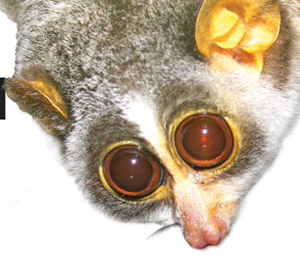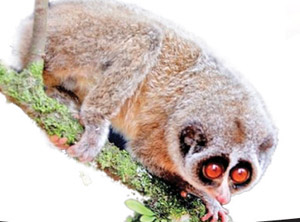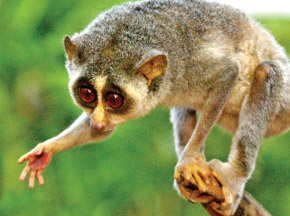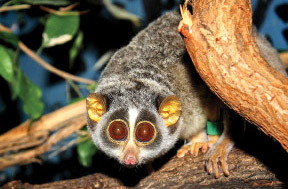Nature trailSlender Loris:
Rare beauty of the wild
It may be no beauty to win the crown at any beauty pageant held in
the Animal Kingdom, but this tiny gremlin-like creature which is not
more than eight inches in
  size
has succeeded in taking centre stage just by making an appearance before
a camera lens. So what is so unique about this tiny primate to become
hot news just because it was spotted by researchers? Well, there is a
good reason for the little loris to be given centre stage, not only in
Sri Lanka, but also the world over. According to the Zoological Society
of London, the loris which was first discovered way back in 1937
disappeared for nearly 60 years soon after its discovery . Researchers
initially thought the loris had become extinct, but then it was sighted
once again in 2002, only to disappear again. Now, almost eight years
later the loris is said to have shown its cute face (yes, every animal
is cute in its own way,) again. So, where was it hiding all these years,
one cannot help but wonder. size
has succeeded in taking centre stage just by making an appearance before
a camera lens. So what is so unique about this tiny primate to become
hot news just because it was spotted by researchers? Well, there is a
good reason for the little loris to be given centre stage, not only in
Sri Lanka, but also the world over. According to the Zoological Society
of London, the loris which was first discovered way back in 1937
disappeared for nearly 60 years soon after its discovery . Researchers
initially thought the loris had become extinct, but then it was sighted
once again in 2002, only to disappear again. Now, almost eight years
later the loris is said to have shown its cute face (yes, every animal
is cute in its own way,) again. So, where was it hiding all these years,
one cannot help but wonder.
Now that it has been spotted naturally there is a big hue and cry
about it being alive!, Letís hope the loris which was captured on camera
recently is not the only one inhabiting the rainforest of our country
today. This would definitely be good news because that means the animal
is no longer threatened with extinction. Isnít it great to know that at
least one tiny creature has been spared the fate of being wiped out of
the face of this Earth, and that too in our very own country? It
certainly is great news. More than this, what is most important is to
know for certain if the loris that has been seen is a new species and
not a subspecies of the red slender loris, which lives in the
rainforests of our country. Scientists are of the view that it is a new
species.
With its extremely distinct orb-like eyes, the Horton Plains slender
loris as the researchers call it, has captured the attention of many,
both here and abroad. So, letís find out more about this little creature
and the other loris species found in our country. The Red Slender Loris
is one of two slender loris species found in Sri Lanka. The other one
being the Grey Slender Loris.
|

This loris was photographed recently. |
 The
Red Slender Loris (Loris tardigradus) is a small, nocturnal prosimian
native to the rainforests of Sri Lanka.It is about eight inches long.
This small, slender primate has large forward facing eyes,long slender
limbs, a well developed index finger and large prominent ears, which are
thin, rounded and hairless at the edges. The ears of the recently
spotted loris are small. Its orb like eyes are its most prominent
feature. On its face it has a central pale stripe that starts above the
eyes and runs down towards the nose. It has no tail eventhough it
resembles a small monkey or squirrel at a glance. The
Red Slender Loris (Loris tardigradus) is a small, nocturnal prosimian
native to the rainforests of Sri Lanka.It is about eight inches long.
This small, slender primate has large forward facing eyes,long slender
limbs, a well developed index finger and large prominent ears, which are
thin, rounded and hairless at the edges. The ears of the recently
spotted loris are small. Its orb like eyes are its most prominent
feature. On its face it has a central pale stripe that starts above the
eyes and runs down towards the nose. It has no tail eventhough it
resembles a small monkey or squirrel at a glance.
The soft dense fur is reddish-brown in colour on the back but the
underside is whitish-grey with a sprinkling of silver hair. Its body
length on average is 7-10 inches in (180-250 mm), with an average weight
of a mere 3-13 oz (85-370 g).The loris in general has a four way grip on
each foot. The big toe opposes the other four toes for a pincer like
grip on branches and food.It is known that the Red Slender Loris favours
lowland rainforests (up to 700 m in altitude), tropical rainforests and
inter-monsoon forests of the south western wet-zone of Sri Lanka. The
most common plant species eaten by the animal is Humboldtia which has a
mutualistic relationship with ants, providing abundant food for
lorises.Lorises are primarily insectivorous but they also eat bird eggs,
berries, leaves, buds and occasionally invertebrates as well as geckoes
and lizards.
To maximize protein and nutrient uptake, these animals are known to
consume every part of their prey, including the scales and bones.The Red
Slender Loris (Loris tardigradus) is endemic to Sri Lanka. Its relative,
the Grey Slender Loris (Loris lydekkerianus) also occurs in India.
There are two subspecies of Red Slender Loris: Loris tardigradus
tardigradus and Loris tardigradus nycticeboides. Loris is the common
name for the strepsirrhine primates of the subfamily Lorinae in the
family Lorisidae.
The taxonomic classification of the species is: Red Slender Loris,
Loris tardigradus. Dry Zone Slender Loris, Loris tardigradus tardigradus;
Horton Plains Slender Loris, Loris tardigradus nyctoceboides
The Red Slender Loris which is endemic to Sri Lanka differs from its
close relative the Gray Slender Loris in its frequent use of rapid
arboreal locomotion.
  It
forms small social groups, containing adults of both sexes as well as
young animals. This species is among the most social of the nocturnal
primates. It
forms small social groups, containing adults of both sexes as well as
young animals. This species is among the most social of the nocturnal
primates.
During daylight hours the animals sleep in groups in branch tangles,
or curled up on a branch with their heads between their legs. The groups
also undertake mutual grooming and play at wrestling. The adults
typically hunt separately during the night. They make nests out of
leaves or find hollows of trees or a similar secure place to live in.
Females are dominant. The female which reaches maturity at 10 months
is the dominant animal of the group. The gestation (pregnancy) period is
166-169 days. It gives birth to one or two young and nurses them for six
to seven months. The lifespan of this species is believed to be around
15-18 years in the wild.
The earlier conception was that lorises were primitive, slow and
solitary. However, recent research has shown that this is not so. The
loris is a very difficult species to research in the wild.
********
Fast facts
* The Horton Plains slender loris, was discovered by photograph after
researchers for the Zoological Society of London, the University of
Colombo and the Open University of Sri Lanka had spent time surveying
the forest.
* Scientists believe the rare Sri Lankan loris primate may belong to
a new species and not ďa subspecies of Sri Lanka Ďs red slender lorisĒ
as originally thought.
* The Red Slender Loris was identified as one of the top-10 ďfocal
speciesĒ in 2007 by the Evolutionarily Distinct and Globally Endangered
(EDGE) project
* The late 2009 rediscovery and capture by a team working under the
Zoological Society of Londonís EDGE programme has resulted in the first
detailed physical examination of the Horton Plains sub-species and the
first-ever photographs of it.
The limited available evidence suggests there may be only about 100
animals still existing, which would make it among the top five
most-threatened primates worldwide.
* The family Lorisidae includes lorises, lemurs, galagos and pottos,
and at least 37 species are found in Africa, South of the Sahara,
Southern India, Sri Lanka, South-Eastern Asia and the East Indies,
except Madagascar
* In Tamil, it is known as Thevangu, a phrase often ascribed to
people who are too thin. In Sinhala the Grey Slender Loris is known as
Alu Unahapuluwa and the Red Slender Loris as the Rathu Unahapuluwa.
The Horton Plains Loris (L. T. Mycticeboides) occurs in the Horton
Plains National Park and possibly in the Sabaragamuwa Province.
Researchers are carrying out a long-term study into the conservation
status of this animal, which was finally photographed after hundreds of
hours of searching. Letís hope it will not disappear again! |

